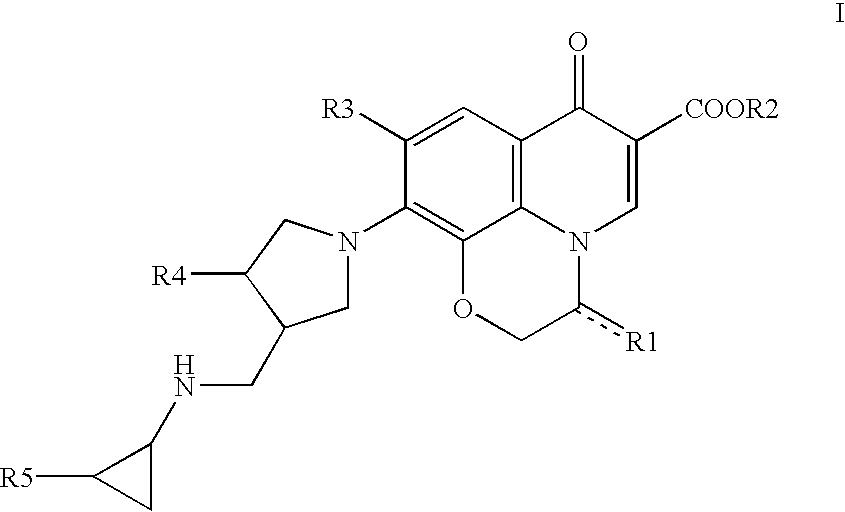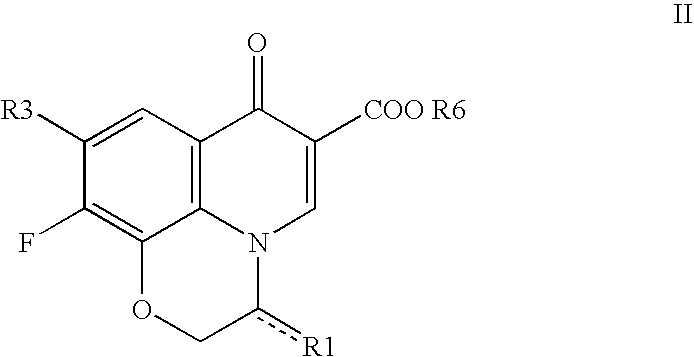10-(3-cyclopropylaminomethyl-1-pyrrolidinyl)pyridobenzoxazinecarboxylic acid derivative effective against resistant bacterium
a technology of pyrrolidinyl and pyrrolidinyl, which is applied in the direction of antibacterial agents, organic chemistry, organic active ingredients, etc., can solve the problems of gram-positive bacteria, difficult use of drugs, and ineffective cures for drug-resistant bacteria, so as to achieve strong antibacterial activity and less susceptible to conventional antibacterial agents
- Summary
- Abstract
- Description
- Claims
- Application Information
AI Technical Summary
Benefits of technology
Problems solved by technology
Method used
Image
Examples
reference example 1
Bis(acetato-O)[(3R)-9,10-difluoro-3-fluoromethyl-2,3-dihydro-7-oxo-7H-pyrido[1,2,3-d,e][1,4]benzoxazine-6-carboxylato-O6, O7]boron
[0016] To a mixture of boric acid (12.8 g) and acetic anhydride (63.4 g), zinc chloride (236 mg) was added and the resulting mixture was stirred at room temperature for 0.5 hours. To this mixture, (3R)-9,10-difluoro-3-fluoromethyl-2,3-dihydro-7-oxo-7H-pyrido[1,2,3-d,e][1,4]benzoxazine-6-carboxylic acid ethyl ester (22.6 g) was added and the mixture was stirred at 60° C. for 2.5 hours. Subsequently, the reaction mixture was concentrated under reduced pressure and the resulting residue was dissolved in ethyl acetate (300 mL). The solution was sequentially washed with a saturated aqueous solution of sodium hydrogen carbonate (2×200 mL) and then with water (100 mL), followed by drying over anhydrous sodium sulfate and concentration under reduced pressure. The resulting residue was purified on a silica gel column (dichloromethane: acetone=7:1), and the eluted...
reference example 2
Synthesis of bis(acetato-O)[(3S)-9,10-difluoro-2,3-dihydro-3-methoxymethyl-7-oxo-7H-pyrido[1,2,3-d,e][1,4]benzoxazine-6-carboxylato-O6, O7]boron
Step 1:
[0019] (3S)-9,10-Difluoro-2,3-dihydro-3-hydroxymethyl-7-oxo-7H-pyrido[1,2,3-d,e][1,4]benzoxazine-6-carboxylic acid ethyl ester (1.30 g) was suspended in anhydrous dimethylformamide (40 mL). Silver oxide (I) (4.63 g) and methyl iodide (1.25 mL) were then added to the suspension. The resulting mixture was stirred at room temperature for 21 hours. Subsequently, insoluble materials were removed from the reaction mixture by filtration and the filtrate was concentrated under reduced pressure. The resulting residue was purified on a silica gel column (dichloromethane: acetone=5:1) to give 740 mg of (3S)-9,10-difluoro-2,3-dihydro-3-methoxymethyl-7-oxo-7H-pyrido[1,2,3-d,e][1,4]benzoxazine-6-carboxylic acid ethyl ester as a white powder.
[0020] MS(EI) m / z: 339 (M+).
[0021] Elementary analysis (%): Calcd for C16H15F2NO5: C, 56.64; H, 4.46; N,...
reference example 3
Synthesis of bis(acetato-O) [(3S)-3-acetoxymethyl-9,10-difluoro-2,3-dihydro-7-oxo-7H-pyrido[1,2,3-d,e][1,4]benzoxazine-6-carboxylato-O6, O7]boron
Step 1:
[0025] (3S)-9,10-Difluoro-2,3-dihydro-3-hydroxymethyl-7-oxo-7H-pyrido[1,2,3-d,e][1,4]benzoxazine-6-carboxylic acid ethyl ester (976 mg) was suspended in anhydrous dichloromethane (30 mL). To the suspension, acetic anhydride (368 mg) and 4-dimethylaminopyridine (5.0 mg) were added and the resulting mixture was refluxed for 1.5 hours while heated. Subsequently, the mixture was allowed to cool and was washed with water. This was followed by drying over anhydrous sodium sulfate and concentration under reduced pressure. The resulting residue was suspended in ethanol and the suspension was filtrated to give 1.04 g of (3R)-3-acetoxymethyl-9,10-difluoro-2,3-dihydro-7-oxo-7H-pyrido[1,2,3-d,e][1,4]benzoxazine-6-carboxylic acid ethyl ester as a white powder.
[0026] MS(EI) m / z: 367(M+).
[0027] Elementary analysis (%): Calcd for C17H15F2NO6: C...
PUM
| Property | Measurement | Unit |
|---|---|---|
| temperature | aaaaa | aaaaa |
| temperature | aaaaa | aaaaa |
| hydrogen pressure | aaaaa | aaaaa |
Abstract
Description
Claims
Application Information
 Login to View More
Login to View More - R&D
- Intellectual Property
- Life Sciences
- Materials
- Tech Scout
- Unparalleled Data Quality
- Higher Quality Content
- 60% Fewer Hallucinations
Browse by: Latest US Patents, China's latest patents, Technical Efficacy Thesaurus, Application Domain, Technology Topic, Popular Technical Reports.
© 2025 PatSnap. All rights reserved.Legal|Privacy policy|Modern Slavery Act Transparency Statement|Sitemap|About US| Contact US: help@patsnap.com



